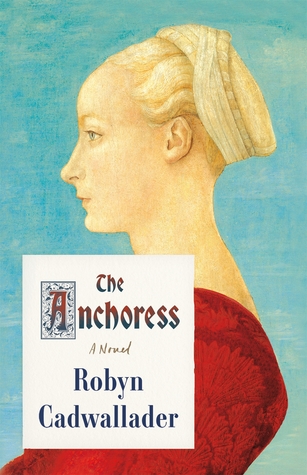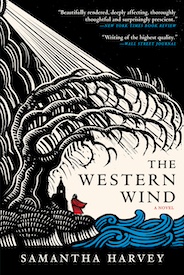If you’re like me, the winter break is prime historical fiction reading time: there’s nothing better than curling up in front of a roaring fire with a mug of tea and a good book that can take you to another time and place. And if you’re really like me, you particularly enjoy sinking into a novel set in the Middle Ages—a busman’s holiday, I suppose?
Here are some of my picks for immersive historical fiction, books that bring back to life certain moments in medieval Europe.
 First up is Robyn Cadwallader’s The Anchoress (2015), which introduces us to Sarah, a teenager in thirteenth-century England who chooses to enter one of the most confined types of Christian religious life. She becomes an anchoress: someone who “dies” to the world around her in order to spend her life in unbroken contemplation in a tiny room attached to the exterior wall of her parish church.
First up is Robyn Cadwallader’s The Anchoress (2015), which introduces us to Sarah, a teenager in thirteenth-century England who chooses to enter one of the most confined types of Christian religious life. She becomes an anchoress: someone who “dies” to the world around her in order to spend her life in unbroken contemplation in a tiny room attached to the exterior wall of her parish church.
In a room only seven paces wide by nine paces long, Sarah hopes to find solace from the pressure to marry and from the grief of losing a beloved sibling—but finds that even when she can no longer freely look on another human face, it’s not so easy to remove herself from the consequences of the past or the events of the present.
Cadwallader’s prose is gentle and her exploration of issues of the body, gender, and religious belief are deft. It’s not always easy to get a modern reader to sympathise with characters whose motivations and impulses may seem so very alien to many people today, but I think she manages it here.
 Where The Anchoress is contained, Dorothy Dunnett’s House of Niccolò series (1986-2000) sprawls. This is probably a less famous series than Dunnett’s other one, her beloved Lymond Chronicles, but it’s got the same epic storytelling, fine-grained historical detail, and cunning shapeshifter of a central character.
Where The Anchoress is contained, Dorothy Dunnett’s House of Niccolò series (1986-2000) sprawls. This is probably a less famous series than Dunnett’s other one, her beloved Lymond Chronicles, but it’s got the same epic storytelling, fine-grained historical detail, and cunning shapeshifter of a central character.
The series begins in 15th-century Bruges, then a trading powerhouse and home to one Nicholas vander Poele. Over time, Nicholas (also known as Niccolò, hence the series title) rises from being a humble dyer’s apprentice to become a powerful force in his own right. Dunnett’s plotting takes us from Flanders to Florence, Iceland to Iberia, Trebizond to Timbuktu, with plenty of political intrigue and adventure along the way.
I found the books engrossing, but be warned that they’re dense, full of events whose true significance can sometimes take hundreds of pages to become clear and oodles of historical allusions—these are not light reads to skim through while lounging by the pool. But if you’re patient and persistent, Dunnett will reward you with climaxes that make you feel like you’ve been punched in the solar plexus.
You know, if you’re into that.
 If you’re not into that but you’d still like a read with some plot to it, try Caroline Roe’s Chronicles of Isaac of Girona (1998-2004). There are eight installments in this series which centres on the eponymous Isaac, a blind Jewish doctor in fourteenth-century Catalonia.
If you’re not into that but you’d still like a read with some plot to it, try Caroline Roe’s Chronicles of Isaac of Girona (1998-2004). There are eight installments in this series which centres on the eponymous Isaac, a blind Jewish doctor in fourteenth-century Catalonia.
Isaac uses his medical knowledge, logical thinking, and understanding of human nature to solve murders, helped by his family and his position as friend of and personal physician to the bishop of Girona. These books are all in the “cosy mystery” subgenre—the violence is largely off-screen—and I think if you like the Cadfael series, you’ll enjoy these.
Sadly I think these books are all now out of print, but you should be able to track down secondhand copies—they’re worth picking up if you can find a copy.
 Travelling back north brings us to The Western Wind (2019) by Samantha Harvey, which is set in a village in late fifteenth-century England. Like the Chronicles of Isaac books, there’s a mysterious death here, and the parish priest, John Reve, strains to understand whether it was a case of accident, suicide, or murder.
Travelling back north brings us to The Western Wind (2019) by Samantha Harvey, which is set in a village in late fifteenth-century England. Like the Chronicles of Isaac books, there’s a mysterious death here, and the parish priest, John Reve, strains to understand whether it was a case of accident, suicide, or murder.
This is one of those books where the whodunnit is not the real point. Harvey is far more interested in the daily rhythms and personal relationships of these villagers, and of their relationship with the land around them, and in undertaking a character study of the lonely, anxious Reve. While Harvey is perhaps not as concerned with historical accuracy as some other novelists, the village which she conjures up here feels convincing and the landscape in which it’s set—isolated within the bend of a river—is a vivid one.
The Western Wind’s unusual structure—events unfold in reverse, a day at a time—adds to its feeling of unsettling tension.
 Lastly, two epic books about seventh-century northern England: Nicola Griffith’s Hild (2013) and Menewood (2023), which are inspired by the life of the real historical figure, the abbess Hilda of Whitby. Hilda was an important figure in the Christianisation of early medieval England, but we know comparatively little about her. Griffith uses what we do know about her as springboards for books of great imagination married with incredibly close attention to “the pattern of the world.”
Lastly, two epic books about seventh-century northern England: Nicola Griffith’s Hild (2013) and Menewood (2023), which are inspired by the life of the real historical figure, the abbess Hilda of Whitby. Hilda was an important figure in the Christianisation of early medieval England, but we know comparatively little about her. Griffith uses what we do know about her as springboards for books of great imagination married with incredibly close attention to “the pattern of the world.”
The first two books cover only the first twenty years or so of the life of Hilda—or Hild, as she’s known here. Smart and fiercely observant, Hild learns over time how to deftly navigate the opportunities and the risks that come with being born into a ruling family in the early Middle Ages, and Griffith pays keen attention to the many relationships—of kinship, of affection, of obligation—that tie Hild to those around her.
If you’re a fan of books with immersive world-building, where you get to see how the ability to read weather patterns and predict the wool yields likely from a particular bit of pasturage can be the difference between success and starvation in a pre-industrial world, I think you’ll enjoy Hild and Menewood. At several hundred pages each, both of these books are serious commitments of time—but ones that I’ve enjoyed, and I very much hope we get to see this Hild mature into the founder of Whitby.
